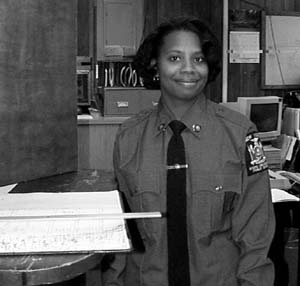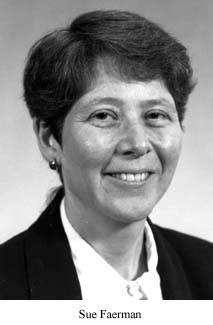New University Police Officer Follows in Family's Footsteps
By Lisa James

With an interest, as well as several family members, in law enforcement, it is no wonder why Onna Cooley is pleased to be a new police officer with the University Police Department (UPD). "I think working here will be a good experience and a good opportunity for me. There are lots of things I can learn from this department. I think it will be a stepping stone to things I want to do later," she said.
Cooley's father is a captain for the Sheriffs Department at the Albany County jail and her husband and brother are both corrections officers.
So far, Cooley says, the best part of her new position has been meeting new people and making connections. Having a chance to help people is another strong point. In addition, she said, being at a University offers the opportunity to help students while they are still young and to give them some guidance.
"We are excited to have Onna Cooley on the UPD force. This represents one step in what I hope will be a number of steps in diversifying our department, both in terms of gender and race," said Frank Wiley, chief of UPD. He added, "She has outstanding people skills and will be seen as a significant asset to the UPD and the community at large."
Originally from Albany and a graduate of Columbia High School in East Greenbush, Cooley attended classes at the University and is planning to resume her studies next semester to complete her degree. "I am very interested in criminal psychology," she said.
In the future, Cooley said she would like to counsel substance abuse and domestic violence offenders and work with inmates to show them ways they can prove themselves once they are released. She would also like to work with juveniles to help make sure they never get on the wrong path in the first place.
Before joining UPD, Cooley was a communication specialist for the New York State Police at Troop G in Loudonville.
She presently lives in East Greenbush with her husband and year-old son.
Construction of Plasma Research Tool is `Pluss' for University
By Christine Hanson McKnightA visiting scientist from Japan, Masatoshi Tokushima, returned to his homeland Nov. 6 after spending a year collaborating with University physicists on leading-edge research in the field of plasma-based materials. Plasmas have become indispensable for advanced materials processing in many high-tech industries, especially the microelectronics industry.
Tokushima, who was on leave from his job at Nippon Electric Co. (NEC), played a lead role in helping University scientists build the PLUSS (for Plasma Understanding Simulation System) instrument, which was designed to allow researchers to more clearly understand fundamental aspects of plasma-surface interactions.
Tokushima said he decided to come to the University at Albany on the strong recommendation of a Japanese colleague who knew of the work of Professor Gottlieb Oehrlein and his group, who have been investigating a number of issues related to low-temperature plasmas.
Tokushima said that, while his company - the largest personal computer manufacturer in Japan - ultimately hopes to benefit from his work, "the best benefit is the human connection with Professor Oehrlein and the other professors and students I've worked with. This is just the beginning."
While Tokushima will return to similar work in his laboratory in Tsukuba in the province of Ibaraka, northeast of Tokyo, Albany graduate students Marcus Doemling and Neal Rueger will continue to perfect the plasma instrument.
"The motivation for this work is plasma processing," explained Oehrlein. "About 30 to 40 percent of the equipment installed in computer chip-manufacturing plants today use plasmas. Our goal is to arrive at the best possible predictive models of plasma processes. This tool will allow us to measure fundamental parameters required for that and provide a solid scientific basis for these models, the `Holy Grail' for those of us in this field."
Oehrlein said that Tokushima's work will be very important in establishing that technology - which can then be used in computer simulation models worldwide.
No other laboratory in the world is carrying out research of the kind possible with the PLUSS instrument, Oehrlein said.
The PLUSS project, he said, has received funding by the National Science Foundation/Department of Energy joint initiative project on Plasma Science, SEMATECH, and LAM Research, the leading supplier of plasma-based etching equipment in the world.
A plasma, Oehrlein explained, is an electrified gas consisting of electrons, ions and neutrals, and is also known as the "Fourth State of Matter" - besides the solid, liquid and gaseous states. The microelectronics industry employs plasma-based etching to produce sub-micron device features in thin films with precisely controlled dimensions. It also uses plasma-enhanced chemical vapor deposition methods to synthesize insulators, conductors, diamond thin films, and high-temperature superconductors. Plasmas are also used to harden the surfaces of cutting tools and modify the surfaces of polymers and other materials.
Even the simplest plasma processing reactor is scientifically extremely complex. The PLUSS tool is a highly sophisticated machine which is designed to simulate experimentally some of the processes that go on in plasma systems
Counseling Psychology Amasses APA Fellows
The Department of Counseling Psychology in the School of Education recently announced that two more of its faculty have been accorded fellow status with the American Psychological Association (APA). Monroe Bruch and Marilyn Stern are the latest recipients of the honor, which has not been an uncommon one for the department's faculty.
"I believe this is a rather extraordinary achievement for the department as a whole," said David Blustein, program coordinator for the department. "The attainment of Fellow status within the APA is a major accomplishment for a psychologist. It represents attaining a level of `unusual and outstanding' achievements within psychological research, theory, or practice. It represents a remarkable level of esteem and status."
The two new fellows join three existing departmental APA fellows: Blustein, Myrna Friedlander, and Susan Phillips. It gives the department five APA Fellows out of a total full-time faculty of eight.
In order to attain fellow status, a scholar needs to be nominated by a current Fellow of APA. The candidate then prepares a statement describing his or her accomplishments and obtains additional letters of support. At that point, a committee within one of the APA divisions (in this case, the Division of Counseling Psychology) evaluates the applications, culminating in recommendations for the APA Council.
"The fact that the counseling psychology department here at the University has been so successful in attaining this level of success certainly speaks favorably of the research and professional service activities of its faculty," said Blustein, who pointed to other indices of excellence within the field that have ranked the department within the top five of doctoral training programs nationwide in counseling psychology. "These rankings generally rely upon the national visibility of the faculty's accomplishments in research and professional leadership," said Blustein.
In addition to the five APA Fellows, the department has two Fulbright Scholars: Michael Ellis and Marilyn Stern.
"The fastest growth industry in the U.S. will soon be the continuing education of adults," distance
learning consultant Susan Bray told the New York State Association for Women in Education at its Oct.
24 conference on "Committing to Professional Excellence Through Life-Long Learning," held in Lake
George.
She borrowed the above quote from social ecologist Peter Drucker to bolster her point that continuing
education needs to be a core mission of universities and colleges, or they will be left behind.
Several of the conference workshops were led by University at Albany professors.
As executive director of "New Vistas . . . Support for Distance Learning," Bray follows trends in the
changing demographics of higher education. Whereas the student between the ages of 18 and 22 was once
the key target population for higher education, Bray said that profile now fits only 20 percent of
all students, with 60 percent older than 25.
"The new majority is the adult part-time learner," said Bray. This new student is looking for a good
education that is affordable, convenient classes given at flexible hours, and an institution that is
willing to work around the needs of the student.
This reflects the changing needs of the workplace, in which the average technical worker must update
his or her skills every 3 to 4 years to stay current, according to Bray, who was the founding
director of the Rensselaer Satellite Video Program, which she led from 1987 to 1996. As a private
consultant, she works with universities and companies in establishing distance learning programs.
Bray noted that as companies feel the pressure to do more with less, employees are becoming more
"virtual" in their communication. Instead of flying to the conference, they attend a video conference
from their own office.
In addition, companies are beginning to see continuing education as a resource for the firm to stay
competitive, not just as a benefit to employees, she noted.
And while the "talking head" model of teaching is declining in favor of on-line courses and a new
distributed learning model, Bray noted, "Does this mean we won't need faculty in the future?
Absolutely not." Professors will always be needed to guide the classroom, even if the students are
accessing the classroom from their home computer.
In fact, some of the fastest growing colleges and universities in the nation, like the University of
Phoenix, offer all of their courses on-line. "Everything is geared toward the convenience of the
student," she said.
Key to this growth are an understanding of and comfort with technology, which will be critical in the
universities of the future. Yet women are still underrepresented in key technology positions.
Now, "on the verge of the 21st Century, women are in danger of being disenfranchised through a lack
of knowledge of the computer," Bray said. By the year 2005, the number of computer engineers and
systems analysts is expected to grow by 90 percent, but women remain a small portion of the workers
in these fields.
"Women can be the change agents as the university moves to more distributed, humanized, egalitarian
learning environments," she said. She added, "If you're not on the Web, get on it."
Conference Highlights Growth of Adult `Part-Timers'
by Greta Petry

